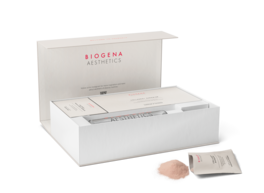What is hyaluronic acid?
Hyaluronic acid, sometimes also called “hyaluronan”, is an endogenous substance in the body that has the unique ability to bind enormous amounts of water. The gel-like substance can be found in several body compartments – not least in the connective tissue of the skin in which it provides moisture, elasticity and resilience. As we age, the body’s production of hyaluronic acid decreases, and this manifests itself gradually as the skin loses moisture, volume and tone.
The effect of hyaluronic acid from the inside: What is it good for?
Hyaluronic acid is an important component of many body compartments. In these, it performs a number of central tasks – above all the following:
Skin
Almost half of our body’s hyaluronic acid content is found in the skin. With its water-binding nature, hyaluronic acid not only moisturises the skin, but also increases its volume, elasticity and resilience.
Connective tissue
In our connective tissue, hyaluronic acid serves as an important building material. This water magnet fills and supports the fabric of the tissue and contributes significantly to its elasticity and resilience.
Eyes
Hyaluronic acid also supports good visibility. The vitreous body, which makes up most of the eye, is made up of 98% water and 2% hyaluronic acid and collagen fibres. While the collagen fibre net acts as a structural sensor for the vitreous body, the water-binding, cushioning hyaluronic acid ensures that it stays in shape.
Joints
Hyaluronic acid is a major component of our synovial fluid. Thanks to its water-binding properties, it acts both as a lubricant and as a shock absorber within the joint. If it is missing, this can lead to painful friction and, as a result, increased joint wear can occur.
Tight skin instead of wrinkles
While our body is optimally supplied with plumping hyaluronic acid at a young age, the body’s own production of hyaluronic acid begins to slow from the mid-twenties and the body’s own supplies also decline over the years. As a result, the skin gradually loses moisture and tone, the skin surface becomes more irregular and wrinkles appear.
Hyaluronic acid – hydrating professional with rejuvenating effect
Who wouldn’t want to keep our appearance fresh into old age? While hyaluronic acid cannot work wonders, its potent moisture magnet can help revitalise mature skin for a more radiant appearance.
External care products with hyaluronic acid: High-quality skin care products with hyaluronic acid provide an immediate effect. The skin feels more radiant, plumper and more supple immediately after applying the moisture booster. However, this effect is usually only of a short duration.
Hyaluronic acid as a nutritional supplement: In the case of oral hyaluronic acid preparations (e.g. capsules, drinks), a little more patience is required until the freshness effect occurs. However, the inner “moisture boost” is deeply effective, more sustainable and not limited to the respective skin regions treated.
In the meantime, human studies have also confirmed that oral hyaluronic acid exhibits true slow-aging qualities. For example, taking 100-300 mg hyaluronic acid (brand raw material GREENIURONIC®) daily for several weeks resulted in...
- Reduced wrinkling (anti-aging effect)
- Increased elasticity of the skin
- Support of cell regeneration
- Improved wound healing
Can you prevent spots with hyaluronic acid?
Hyaluronic acid appears to be a good choice not only for dry skin, but also for blemishes. Blemishes such as pimples or blackheads are primarily due to the increased productivity of the sebaceous glands. Studies suggest that hyaluronic acid introduced into the dermis is able to regulate overproductivity in acne and help the skin recover.
Hyaluronic acid for the joints
Hyaluronic acid is not only excellent as a “skin food”. Our joints also love the active ingredient that makes them run like lubricated wheels. Made by the cartilage cells and the joint mucosa, the body’s own hyaluronic acid ensures that our synovial fluid is thick (viscous), can cushion shocks well and protects the cartilage surfaces against friction. In the course of inflammation (e.g. osteoarthritis), injuries or as the simple effect of aging, the availability of hyaluronic acid in the joint can decrease and lead to the increased friction of the cartilage surfaces. A particularly important property discovered in studies in this context is the additional protection of the chondrocytes, the cartilage cells.
Hyaluronic acid in osteoarthritis – you work better when lubricated!
Targeted intake of hyaluronic acid can ease joint problems. In a clinical study, oral administration of 200 mg hyaluronic acid daily over a period of 12 months led to a reduction in knee arthrosis symptoms in persons aged 70 years and younger.
Special brand raw materials are particularly recommended, the effect of which is confirmed by studies. Greeniuronic®, a hyaluronic acid of plant origin, can provide useful support for osteoarthritis. In in vitro studies, it reduced inflammatory processes, protected cartilage cells from free radicals and at the same time stimulated the body’s own production of hyaluronic acid in cartilage cells.
Hyaluronic acid for the hair
Hyaluronic acid is a beauty all-rounder because the moisture magnet not only fills the skin’s moisture depots, it also supplies dry and damaged hair with an extra helping of moisture. While external applications in the form of serums or conditioners are usually used for this application, the water-binding property of orally ingested hyaluronic acid can also potentially affect the hydration of the hair roots, which also supports hair vitality.
Are hyaluronic acid capsules good during menopause?
During menopause, there is a major hormonal change in the female body. The decreasing oestrogen level not only leads to increased collagen and elastin degradation, but the content of plumping hyaluronic acid also decreases steadily. These internal changes are also reflected on the outside, in the skin. The skin tissue loses volume and plumpness, the skin’s tightness diminishes, and wrinkles appear.
Supplements containing hyaluronic acid, such as capsules or drinks, are the perfect slow-aging answer for the treatment of mature skin. Studies show that the moisture booster helps to refresh your complexion by diminishing wrinkles and making the skin look firmer, more elastic and smoother.
It is not only the skin that suffers from the consequences of declining hyaluronic acid levels. The loss can also worsen the quality of the joint fluid and promote joint problems. Supplements containing hyaluronic acid can also offer support in this context and contribute to the maintenance of articular fluid.
Hyaluronic acid for men
Whether it’s rejuvenated skin, plumped connective tissue or lubricated joints, hyaluronic acid is a universally effective substance that does not differentiate between the genders. After all, the body's own production of hyaluronic acid starts slowing down from the age of 25 for all of us, whether male or female.
However, not all hyaluronic acid is the same.
Hyaluronic acid is a beloved child of the cosmetics industry. A variety of day creams, night creams, face masks, etc. count on the proven moisturising ingredient. It is now also included in nutritional supplements. But are there differences to the hyaluronic acid used in cosmetics? And can our body even use oral hyaluronic acid? Studies of recent years clarify this point.
Low molecular weight hyaluronic acid vs. high molecular weight hyaluronic acid
Chemically speaking, there is not one single form of hyaluronic acid alone. The care substance can be found on the market in different qualities: Low-molecular hyaluronic acid has a longer-term effect and is stored in the connective tissue. Its molecules are smaller, allowing them to penetrate deeper into the skin. The anti-wrinkle effect lasts longer. High molecular hyaluronic acid, on the other hand, cannot penetrate as deeply into the skin. It forms a film on the outermost layer of the skin that hydrates and improves elasticity. Fine lines and wrinkles appear smoother and fuller. The effect can be seen more quickly.
Taking hyaluronic acid orally: What about hyaluronic acid from nutritional supplements?
The research team around Kawada looked at this question. Its study showed that, when administered orally, both low and high molecular hyaluronic acid is absorbed into the tissue and distributed there, the latter being broken down into smaller components by intestinal bacteria before being transported to their destination. Hyaluronic acid can therefore also be effectively supplied to the body in the form of nutritional supplements.
Hyaluronic acid as a nutritional supplement: Hyaluronic acid capsules, tablets, drinks, etc.
Advantages of oral intake over creams and syringes
Whether you use hyaluronic acid creams, syringes or food supplements depends primarily on the starting position, personal preferences and the desired effect.
The advantages of hyaluronic acid supplements compared to injections: In contrast to injections, hyaluronic acid supplements can be used easily at home. Consultation with healthcare professionals is not absolutely necessary and taking it is pain free. In terms of joint health, hyaluronic acid preparations taken orally are particularly suitable for the prevention of premature joint wear and for targeted use in mild to moderate arthrosis. In skin questions, the long-term use of hyaluronic acid-containing preparations achieves a natural skin-smoothing effect. Injections are only to be carried out by specialist personnel and require a detailed definition of the areas and sites that are to be treated, since the site of action is selective.
The advantages of hyaluronic acid supplements compared to injections: Compared to hyaluronic acid creams, oral hyaluronic acid also works in the deep skin layers. Although the skin rejuvenating effect is only achieved after 4-8 weeks with internal use, it is all the more sustainable for this.
Vegan hyaluronic acid
In the past, hyaluronic acid was generally obtained from animal raw materials. However, in recent times it has also been possible to produce the active substance in a vegan-friendly manner. GREENIURONIC® represents the vegan revolution in hyaluronic acid. This is the world’s first patented purely plant-based hyaluronic acid from Tremella fuciformis extract, a white mushroom species commonly used in traditional Chinese medicine. The skin-conditioning effect of GREENIURONIC® has already been confirmed in several studies: 100-300 mg GREENIURONIC® daily reduces wrinkles, increases skin elasticity, supports cell regeneration and improves wound healing.
Onset of action after taking hyaluronic acid powder, capsules, etc.
How quickly you can expect results after taking hyaluronic acid powder, capsules, etc. depends on several factors. These include the respective initial situation, the reason for use, the quality of the product, the selected dosage and the use of potential hyaluronic acid boosters. In a clinical study conducted with the hyaluronic acid brand raw material GREENIURONIC®, 6 weeks of use led to increased moisture content and smoothness in people with dry skin. Other clinical studies showed a positive effect of 120 mg hyaluronic acid daily on crow’s feet around the eyes and in generally reducing wrinkles after 12 weeks.
Taking hyaluronic acid
How much hyaluronic acid should you take per day?
How much hyaluronic acid should be taken per day depends on the respective initial situation, the preparation used and the corresponding reason for use. For example, 100-300 mg hyaluronic acid (GREENIURONIC®) daily is recommended for a fresher, smoother and plumper complexion. For joint problems, such as osteoarthritis, the dosage usually starts at 50-100 mg daily. Ideally, for joint questions, the hyaluronic acid should be supplemented with other anti-inflammatory or cartilage-relevant nutrients. If you would like individual advice on hyaluronic acid, you can contact specialist doctors, practices or wellness facilities.
Combining collagen and hyaluronic acid?
Both collagen and hyaluronic acid are two particularly bright stars in the skincare firmament. The combination of both makes the most of their care benefits. The two slow-aging ingredients not only complement each other perfectly, they also boost their mutual anti-aging effects. While hyaluronic acid is a super moisturiser and plumps the skin from within, collagen helps retain moisture and gives skin tissue firmness and elasticity. You can find collagen powder here.
When it comes to joint care, collagen and hyaluronic acid are also excellent at complementing each other. Hyaluronic acid keeps the synovial fluid thick (= viscous), providing effortless lubrication and a kind of shock absorption. For example, collagen is an essential component of the cartilage that plays an important role in the pressure resistance of the joints.
Which is better: hyaluronic acid or collagen?
Both hyaluronic acid and collagen are essential components of the skin and both are vital for a radiant complexion. The former plumps the skin from the inside by deeply hydrating the skin, the latter – together with elastin – forms the skin’s base structure and gives it firmness and elasticity. The same applies to joint care, where each of the two vital elements reveal their effects in different ways. So why not take advantage of the strengths of both “care professionals” right away?
Combine hyaluronic acid with vitamin A and vitamin C?
Vitamin A (retinol) and vitamin C are classic skin vitamins that support the vitality of the skin in their own right – but even better together with hyaluronic acid. The fat-soluble vitamin A has cell-regenerating properties and stimulates cell renewal. In addition, together with vitamin C, it plays a role in the formation of collagen, which, together with elastin fibres, forms the basic structure of the skin: While vitamin A stimulates structural protein production, vitamin C contributes to healthy collagen formation. Vitamin C also contributes to the protection of cells from free radicals – aggressive molecules that accelerate skin aging in excess (e.g. due to intensive sunbathing). In a thorough skincare routine, all three active ingredients definitely have their rightful place.
Which is better: Retinol or hyaluronic acid?
Retinol and hyaluronic acid are two beauty heroes with different properties. While retinol promotes skin renewal and stimulates collagen synthesis, hyaluronic acid plumps the skin from within, softens wrinkles and provides a hydrating boost of freshness. Whether hyaluronic acid or retinol is better depends on the needs of the respective skin. But why not take advantage of the benefits of both beauty superheroes?
Glucosamine, chondroitin and hyaluronic acid
In order to run as if well lubricated, joints require two things: Selected nutrients and regular exercise. In addition to the already mentioned hyaluronic acid, glucosamine and chondroitin are also among the so-called joint nutrients. Both substances not only nourish cartilage tissue; if the tissue is damaged, their targeted intake also promotes cartilage regeneration in the long term. Since the joint cartilage is not connected to the bloodstream, cartilage nutrients only penetrate to the cartilage during joint movements, through joint lubrication. Therefore, the following applies here in the truest sense of the word: Use it or lose it.
Can you take hyaluronic acid during pregnancy and breastfeeding?
Since there are no studies on the intake of hyaluronic acid during pregnancy and lactation so far, the internal use of preparations containing hyaluronic acid is advised against as a precaution. It is recommended that you should consult with your treating healthcare professional in this regard, who can provide proper information on this.
Nutritive hyaluronic acid booster
Smart active substance combinations can supplement or even enhance the effect of hyaluronic acid. Different hyaluronic acid boosters are used depending on the area of application.
Beneficial hyaluronic acid boosters for beautiful skin sometimes include collagen, ceramides (= skin lipids), pantothenic acid, silicon, vitamin A, vitamin C, vitamin B6, biotin, selenium, zinc and special herbal active substances (e.g. melon juice concentrate, grape seed extract, pomegranate extract, hibiscus extract).
Among the most nutritious hyaluronic acid boosters in joint health are glucosamine and chondroitin sulphate, type II native collagen, vitamin C, vitamin D3, vitamin E, manganese, copper and selenium.
How hyaluronic acid is produced
Hyaluronic acid was previously exclusively obtained from animal sources (e.g. from cockscombs). The desired hyaluronic acid was extracted from the animal raw material using a complex process.
Nowadays, biotechnological methods enable the production of vegan hyaluronic acid. The brand raw material GreenIuronic®, which is the world’s first hyaluronic acid derived exclusively from plant sources, is considered particularly innovative. The raw material for GreenIuronic® is the Tremella mushroom – a white mushroom species that is mainly located in the subtropical forests of East Asia, South America, Europe and North America. The extraction process used to obtain the GreenIuronic® hyaluronic acid is completely natural and does not use any chemicals.
Conclusion
Hyaluronic acid has taken the beauty industry by storm. The much-lauded “slow-aging” substance is no longer only found in external applications. Ingested as a supplement, the super moisturiser cushions wrinkles from the inside, leaving skin looking fresher and more radiant. However, targeted hyaluronic acid intake not only benefits the beauty of the skin, but also the vitality of other body structures (such as the eyes and joints), which contain hyaluronic acid naturally.
Frequently asked questions about hyaluronic acid:
Oral hyaluronic acid preparations plump up wrinkles from the inside out and make the skin appear fresher and more youthful again. In our joints, hyaluron acts as an important protective substance by improving the lubricating and shock-absorbing properties of the synovial fluid.
Foods that contain hyaluronic acid include, for example, fish such as gilthead seabream and mackerel, the cartilage tissue of beef, pork and chicken as well as bone broths cooked from them.
Quality and dosage play an important role in the effect of hyaluronic acid. Branded raw materials, such as GREENIURONIC® for the skin and Mobilee® for the joints, have been tested in several clinical studies that have confirmed their effectiveness.
Thanks to its enormous water-binding capacity, hyaluronic acid can moisturise the skin and give it elasticity and resilience.
Reference:
Hsu T-F et al. 2021. Oral Hyaluronan Relieves Wrinkles and Improves Dry Skin: A 12-Week Double-Blinded, Placebo-Controlled Study. Nutrients. 2021 Jun 28;13(7):2220.
Göllner I et al. 2017. Ingestion of an Oral Hyaluronan Solution Improves Skin Hydration, Wrinkle Reduction, Elasticity, and Skin Roughness: Results of a Clinical Study. J Evid Based Complementary Altern Med. 2017 Oct; 22(4): 816–823.
Papakonstantinou E et al. 2012. Hyaluronic acid: A key molecule in skin aging. Dermatoendocrinol. 2012 Jul 1; 4(3): 253–258.
Chakrabarti B. 1994. Hyaluronic Acid in Normal, Aged and Diseased Vitreous. National Institute of Health, Schepens Eye Research Institute. Boston 1994.
Kawada C et al. 2015. Ingestion of hyaluronans (molecular weights 800 k and 300 k) improves dry skin conditions: a randomized, double blind, controlled study. J Clin Biochem Nutr. 56(1):66-73.
Oe M et al. 2017. Oral hyaluronan relieves wrinkles: a double-blinded, placebo-controlled study over a 12-week period. Clin Cosmet Investig Dermatol. 10:267-273
Tashiro T, Seino S, Sato T et al. Oral administration of polymer hyaluronic acid alleviates symptoms of knee osteoarthritis: a double-blind, placebo-controlled study over a 12-month period. Scientif World J.2012
www.vivatis.com, Zugriff: 08.2023
Bioibérica. 2003. Study on the chondroprotective effects of Hyal-Joint.
Moller, I. et al. 2009. LB012 oral administration of a natural extract rich in hyaluronic acid for the treatment of knee OA with synovitis: a retrospective cohort study. Clin Nutr Suppl. 4(2):171–2
Jung Y R et al. 2017. Hyaluronic Acid Decreases Lipid Synthesis in Sebaceous Glands. J Invest Dermatol. 2017 Jun;137(6):1215-1222.
Kawada C et al. 2015. Ingestion of hyaluronans (molecular weights 800 k and 300 k) improves dry skin conditions: a randomized, double blind, controlled study. J Clin Biochem Nutr. 56(1):66-73.
Oe M et al. 2017. Oral hyaluronan relieves wrinkles: a double-blinded, placebo-controlled study over a 12-week period. Clin Cosmet Investig Dermatol. 10:267-273.
Pavicic, T. et al. 2011. Efficacy of cream-based novel formulations of hyaluronic acid of different molecular weights in anti-wrinkle treatment. J Drugs Dermatol. 10(9):990–1000.
Kawada, C. et al. 2014. Ingested hyaluronan moisturizes dry skin. Nutr J. 13:70.
www.mikronaehrstoffcoach.com, Zugriff: Mai 2024.
https://www.hyaluron.biz/wie-wird-hyaluron-hergestellt.html, Zugriff: Mai 2024.










